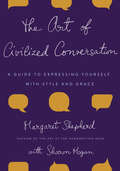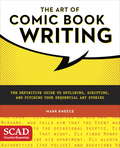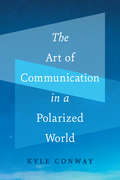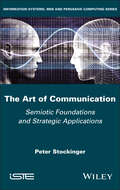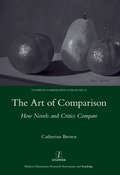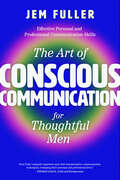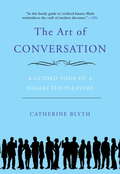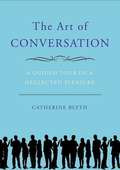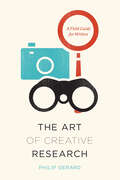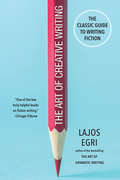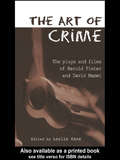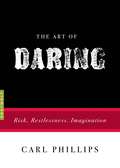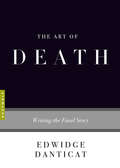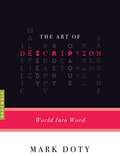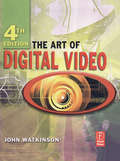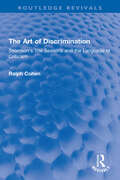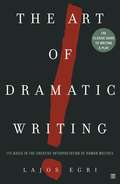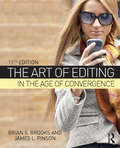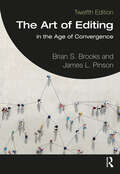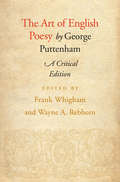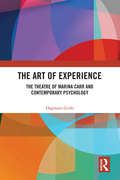- Table View
- List View
The Art of Civilized Conversation: A Guide to Expressing Yourself With Style and Grace
by Margaret Shepherd Sharon HoganIn our fast-paced, electronic society, the most basic social interaction—talking face-to-face—can be a challenge for even the most educated and self-assured individuals. And yet making conversation is a highly practical skill: those who do it well shine at networking parties, interviews, and business lunches. Good conversation also opens doors to a happier love life, warmer friendships, and more rewarding time with family. For those intimidated by the complexity of personal interaction, or those simply looking to polish their speaking skills,The Art of Civilized Conversationis a powerful guide to communicating in an endearing way. In its pages, author Margaret Shepherd offers opening lines, graceful apologies, thoughtful questions, and, ultimately, the confidence to take conversations beyondhello. From the basics—first impressions, appropriate subject matter, and graceful exits—to finding the right words for difficult situations and an insightful discussion of body language, Shepherd uses her skilled eye and humorous anecdotes to teach readers how to turn a plain conversation into an engaging encounter. Filled with common sense and fresh insight,The Art of Civilized Conversationis the perfect inspiration not only for what to say but for how to say it with style.
The Art of Comic Book Writing
by Mark KneeceA practical guide for beginner and advanced comic book writers that outlines the steps needed to successfully craft a story for sequential art. With this latest book in the SCAD Creative Essentials series from the esteemed Savannah College of Art and Design, comics writer and instructor Mark Kneece gives aspiring comic book writers the essential tools they need to write scripts for sequential art with confidence and success. He provides a practical set of guidelines favored by many comic book publishers and uses a unique trial and error approach to show would-be scribes the potential pitfalls they might encounter when seeking a career in comics writing. Supported by examples of scripting from SCAD's students, faculty, and alumni,The Art of Comic Book Writing strips away the mysteries of this popular artform and provides real-world advice and easy-to-follow examples for those looking to write for the comics medium.
The Art of Communication in a Polarized World
by Kyle ConwayPeople’s minds are hard to change. In North America and elsewhere, communities are fractured along ideological lines as social media and algorithms encourage individuals to seek out others who think like they do and to condemn those that don’t. This social and political polarization has resulted in systemic discrimination and weaponized communication trends such as gaslighting and fake news. In this compelling new book, Kyle Conway confronts the communication challenges of our modern world by navigating the space between opposing perspectives. Conway explores how individuals can come to understand another person's interpretation of the world and provides the tools for shaping effective arguments capable of altering their perspective. Drawing on the theory of cultural translation and its dimensions of power, meaning, and invention, Conway deepens our understanding of what it means to communicate and opens the door to new approaches to politics and ethics. An essential guide for surviving in our polarized society, this book offers concrete strategies for refining how values and ideas are communicated.
The Art of Communication: Semiotic Foundations and Strategic Applications (ISTE Invoiced)
by Peter StockingerThe Art of Communication combines over two decades of research and teaching into a comprehensive guide on strategic communication. Grounded in the theoretical and methodological frameworks of 'situated communication' and 'communication project', this book highlights an understanding of both traditional and emerging communication practices. It particularly focuses on new genres, such as branding, design and digital communication strategies, and introduces the innovative concept of 'textscapes' – specially crafted environments to fulfill communicative objectives. This book is enriched with practical examples and is particularly relevant in multicultural and international settings, providing essential insights for adapting communication strategies to diverse cultural contexts.
The Art of Comparison: How Novels and Critics Compare
by Catherine Brown"Comparison underlies all reading. Readers compare words to words, and books to all the other books which they have read. Some books, however, demand a particular comparative effort - for example, novels which contain parallel plot lines. In this ambitious and important study Catherine Brown compares Daniel Deronda with Anna Karenina and Women in Love in order to answer the following questions: why does one protagonist in each novel fail whilst another succeeds? Can their failure and success be understood on the same terms? How do the novels' uses of comparison compare to each other? How relevant is George Eliot's influence on Lev Tolstoi, and Tolstoi's on D. H. Lawrence? Does Tolstoi being a Russian make this a 'comparative' literary study? And what does the 'comparative' in 'comparative literature' actually mean? Criticism is combined with metacriticism, to explore how novels and critics compare."
The Art of Conscious Communication: Effective Personal and Professional Communication Skills
by Jem Fuller&“An enlightening guide to redefining masculinity . . . helping [the modern man] navigate conversations with empathy, clarity, and respect.&” —Scott Jeffrey Miller, bestselling author and podcast host Embrace the power of conscious communication and become part of a new generation of emotionally aware, respectful men. Your journey towards enhanced relationships and a more fulfilling life begins here. In this transformative guide, author Jem Fuller draws on 20 years of coaching and leadership, providing strategies to enhance communication skills. Explore the depths of personal discovery through honest stories, discovering how small steps in awareness can lead to significant changes in relationships and results. It&’s not just a book. In a world where communication shapes the essence of our relationships and results, Fuller challenges conventional norms that may hinder effective expression. The Art of Conscious Communication for Thoughtful Men is a guide to thinking, focusing, acting, and communicating in ways that profoundly impact both individual lives and the lives of those around you. The book urges men to break free from societal constraints, offering practical strategies for navigating complex emotions and conversations. As you delve into Jem&’s colorful life experiences and leadership insights, witness the potential for positive societal change and a more fulfilling life through the profound impact of conscious communication. Inside, you&’ll find: Masterful coaching strategies for effective communication Leadership insights honed over two decades Practical guidance for navigating complex emotions Stories from a diverse life, enhancing cultural understanding If you liked books such as The First Minute, The Effective Communication Method, or 7 Winning Conflict Resolution Techniques, you&’ll love The Art of Conscious Communication for Thoughtful Men.
The Art of Conversation
by Catherine BlythEvery day we use our mobiles and computers to communicate, but ironically we are losing touch with face-to-face talk. Catherine Blyth reveals the endless possibilities of conversation and shows that when it works it can come close to heaven. With examples from Elizabeth I to Tommy Cooper, courtesans to nomads, The Art of Conversation is full of tips on listening, the perfect handshake, talking shop and surviving conversational bores. Be it sharing a joke with a stranger, sparking a new idea or just letting off steam with a friend, there are infinite adventures to be had if you break the ice and say hello . . .
The Art of Conversation: A Guided Tour of a Neglected Pleasure
by Catherine BlythIn The Art of Conversation, Catherine Blyth eloquently points out the sorry state of disrepair that conversation has fallen into and then, taking examples from history, literature, philosophy, anthropology, and popular culture, she gives us the tools to rebuild.
The Art of Conversion
by Cécile FromontBetween the sixteenth and the nineteenth centuries, the west central African kingdom of Kongo practiced Christianity and actively participated in the Atlantic world as an independent, cosmopolitan realm. Drawing on an expansive and largely unpublished set of objects, images, and documents, Cecile Fromont examines the advent of Kongo Christian visual culture and traces its development across four centuries marked by war, the Atlantic slave trade, and, finally, the rise of nineteenth-century European colonialism. By offering an extensive analysis of the religious, political, and artistic innovations through which the Kongo embraced Christianity, Fromont approaches the country's conversion as a dynamic process that unfolded across centuries. The African kingdom's elite independently and gradually intertwined old and new, local and foreign religious thought, political concepts, and visual forms to mold a novel and constantly evolving Kongo Christian worldview. Fromont sheds light on the cross-cultural exchanges between Africa, Europe, and Latin America that shaped the early modern world, and she outlines the religious, artistic, and social background of the countless men and women displaced by the slave trade from central Africa to all corners of the Atlantic world.
The Art of Creative Research: A Field Guide for Writers (Chicago Guides to Writing, Editing, and Publishing)
by Philip GerardAll writers conduct research. For some this means poring over records and combing, archives but for many creative writers research happens in the everyday world—when they scribble an observation on the subway, when they travel to get the feel for a city, or when they strike up a conversation with an interesting stranger. The Art of Creative Research helps writers take this natural inclination to explore and observe and turn it into a workable—and enjoyable—research plan. It shows that research shouldn’t be seen as a dry, plodding aspect of writing. Instead, it’s an art that all writers can master, one that unearths surprises and fuels imagination. This lends authenticity to fiction and poetry as well as nonfiction. Philip Gerard distills the process into fundamental questions: How do you conduct research? And what can you do with the information you gather? He covers both in-person research and work in archives and illustrates how the different types of research can be incorporated into stories, poems, and essays using examples from a wide range of writers in addition to those from his own projects. Throughout, Gerard brings knowledge from his seasoned background into play, drawing on his experiences as a reporter and a writer of both fiction and nonfiction. His enthusiasm for adventure is infectious and will inspire writers to step away from the keyboard and into the world. “Research can take you to that golden intersection where the personal meets the public, the private crosses the universal, where the best literature lives,” Gerard writes. With his masterly guidance, anyone can become an expert in artful investigation.
The Art of Creative Writing
by Lajos Egri'Every type of creative writing depends upon the credibility of a character. ' This fundamental observation serves as the basis of Lajos Egri's book. In it he offers a step by step guide for the development of fiction, plays, and TV and radio scripts. He shows how to probe the secrets of human motivation to define flesh-and-blood characters who create suspense and conflict, who grow emotionally under stress and strain.
The Art of Creative Writing: The Classic Guide to Writing Fiction
by Lajos Egri&“One of the few truly helpful books on fiction writing.&” —Chicago Tribune Go beyond Stephen King&’s On Writing to master the fundamentals of great storytelling with this foundational guide that reveals the essential elements of what makes the best fiction. The Art of Creative Writing is a timeless testament to the power of dialogue and character development that is accessible for every level of writer from beginner to established author. As in the bestselling The Art of Dramatic Writing, still considered one of the most essential books on playwriting more than 75 years after publication, the author outlines in detail his highly acclaimed Egri Method of Creative Writing and shows how to apply it to all fiction formats—novels, short stories, and screenplays. Grounded in Egri&’s assertion that &“Every type of creative writing depends upon the credibility of a character,&” here is concise, clear advice on the most important element of good writing: characterization. Step by step, Egri shows writers how to probe the secrets of human motivation to create flesh-and-blood characters who create suspense and conflict, and who grow emotionally under stress and strain. As practical as it is inspiring, The Art of Creative Writing remains a timeless, illuminating guide that teaches every writer, and aspiring writer, how to create works that are both compelling and enduring.
The Art of Crime: The Plays and Film of Harold Pinter and David Mamet (Studies in Modern Drama #21)
by Leslie KaneFirst Published in 2004. Routledge is an imprint of Taylor & Francis, an informa company.
The Art of Daring: Risk, Restlessness, Imagination (Art of...)
by Carl PhillipsThe award-winning poet Carl Phillips's invaluable essays on poetry, the tenth volume in the celebrated Art of series of books on the craft of writingIn seven insightful essays, Carl Phillips meditates on the craft of poetry, its capacity for making a space for possibility and inquiry. What does it mean to give shapelessness a form? How can a poem explore both the natural world and the inner world? Phillips demonstrates the restless qualities of the imagination by reading and examining poems by Ashbery, Bogan, Frost, Niedecker, Shakespeare, and others, and by considering other art forms, such as photography and the blues. The Art of Daring is a lyrical, persuasive argument for the many ways that writing and living are acts of risk. "I think it's largely the conundrum of being human that makes us keep making," Phillips writes. "I think it has something to do with revision—how, not only is the world in constant revision, but each of us is, as well."
The Art of Death: Writing the Final Story (Art of...)
by Edwidge DanticatA moving reflection on a subject that touches us all, by the bestselling author of Claire of the Sea LightEdwidge Danticat’s The Art of Death: Writing the Final Story is at once a personal account of her mother dying from cancer and a deeply considered reckoning with the ways that other writers have approached death in their own work. “Writing has been the primary way I have tried to make sense of my losses,” Danticat notes in her introduction. “I have been writing about death for as long as I have been writing.” The book moves outward from the shock of her mother’s diagnosis and sifts through Danticat’s writing life and personal history, all the while shifting fluidly from examples that range from Gabriel García Márquez’s One Hundred Years of Solitude to Toni Morrison’s Sula. The narrative, which continually circles the many incarnations of death from individual to large-scale catastrophes, culminates in a beautiful, heartrending prayer in the voice of Danticat’s mother. A moving tribute and a work of astute criticism, The Art of Death is a book that will profoundly alter all who encounter it.
The Art of Description: World into Word (Art of...)
by Mark Doty"It sounds like a simple thing, to say what you see," Mark Doty begins. "But try to find words for the shades of a mottled sassafras leaf, or the reflectivity of a bay on an August morning, or the very beginnings of desire stirring in the gaze of someone looking right into your eyes . . ." Doty finds refuge in the sensory experience found in poems by Blake, Whitman, Bishop, and others. The Art of Description is an invaluable book by one of America's most revered writers and teachers.
The Art of Digital Video
by John WatkinsonThe industry "bible" is back and it's better than ever. The Art of Digital Video has served as the ultimate reference guide for those working with digital video for generations. Now this classic has been revised and re-written by international consultant and industry leader John Watkinson to include important technical updates on this ever-evolving topic. The format has also been improved to include optional sections that provide additional information that you can choose to skip or investigate further, depending on your interests and comfort level with the subject. As the worlds of film, digital imaging, and computing have converged, this book has evolved to remain current and relevant, while still remaining the classic that experts in the field have trusted for years.
The Art of Discrimination: Thomson's The Seasons and the Language of Criticism (Routledge Revivals)
by Ralph CohenFirst published in 1964, The Art of Discrimination is a study in the relation between critical theory and practice, taking as its test-case James Thomson’s The Seasons, the poem which was, according to Johnson, of "a new kind". Professor Cohen explores the different applications of criticism from 1750 to 1950, analysing specific interpretations of the poem that altered, contradicted or supported poetic theory. In doing so, he introduces new techniques to supplement traditional critical commentary: illustrations are treated as interpretations and critical language is related to non-literary as well as literary information. In treating the history of critical interpretation, the reprinting of editions and past interpretations are considered along with contemporary statements as necessary to define a literary period. The book offers alternatives to theories of organicism and to those of the arbitrariness of literary history by defining the kinds of continuities that exist in criticism. As analysis of criticism, it studies how men think about literature, the extent to which such thinking resists systematization and those elements in it which can be controlled and organized and transmitted. The book will appeal to students of literature and critical theory.
The Art of Dramatic Writing: Its Basis in the Creative Interpretation of Human Motives
by Lajos EgriLearn the basic techniques every successful playwright knows Among the many "how-to" playwriting books that have appeared over the years, there have been few that attempt to analyze the mysteries of play construction. Lajos Egri's classic, The Art of Dramatic Writing, does just that, with instruction that can be applied equally well to a short story, novel, or screenplay. Examining a play from the inside out, Egri starts with the heart of any drama: its characters. All good dramatic writing hinges on people and their relationships, which serve to move the story forward and give it life, as well as an understanding of human motives -- why people act the way that they do. Using examples from everything from William Shakespeare's Romeo and Juliet to Henrik Ibsen's A Doll's House, Egri shows how it is essential for the author to have a basic premise -- a thesis, demonstrated in terms of human behavior -- and to develop the dramatic conflict on the basis of that behavior. Using Egri's ABCs of premise, character, and conflict, The Art of Dramatic Writing is a direct, jargon-free approach to the problem of achieving truth in writing.
The Art of Dramaturgy
by Anne CattaneoAn introduction to the mysterious theater role of a dramaturg by a legend in the field Anne Cattaneo was among the first Americans to fill the role of dramaturg, one of theater&’s best kept secrets. A combination of theater artist, scholar, researcher, play advocate, editor, and writer&’s friend, it is the job of a dramaturg to &“reflect light back on the elements that are already in play,&” while bringing a work of theater to life. Cattaneo traces the field from its beginnings in the eighteenth century to the present and chronicles the multitude and variety of tasks a dramaturg undertakes before, during, and after a production is brought to the stage. Using detailed stories from her work with theater artists such as Tom Stoppard, Wendy Wasserstein, Robert Wilson, Shi-Zheng Chen, and Sarah Ruhl, as well as the discovery of a &‘lost&’ play by Langston Hughes and Zora Neale Hurston, Cattaneo provides an invaluable manual to those studying, working in, and interested in this most fascinating profession.
The Art of Editing in the Age of Convergence: In The Age Of Convergence
by Brian S. Brooks James L. PinsonThe Art of Editing in the Age of Convergence remains the most comprehensive and widely used text on editing in journalism. This latest edition continues to shift the focus toward online multimedia as more and more people get their news that way. Amid these changes, the authors continue to stress the importance of taking the best techniques learned in print and broadcast editing and applying them to online journalism. The reality is that most people now often first learn of breaking news on Facebook or Twitter, and therefore the challenge for journalists in this new media world is distinguishing the quality and dependability of their work from all the fake news and propaganda memes, now so common online. This book is designed to help serious news providers produce a product that is well-edited and grounded in the best practices of journalism.
The Art of Editing: in the Age of Convergence
by Brian S. Brooks James L. PinsonNow in its 12th edition, this core text is the most comprehensive and widely used textbook on editing in journalism. Thoroughly revised and updated to incorporate more online and multimedia formats, this hands-on guide offers a detailed overview of the full process of journalistic editing, exploring both the "micro" aspects of the craft, such as style, spelling and grammar, and "macro" aspects, including ethics and legality. Recognizing the pronounced global shift toward online multimedia, the authors continue to stress the importance of taking the best techniques learned in print and broadcast editing and applying them to online journalism. This new edition also includes an in-depth discussion of the role editors and journalists can play in recapturing the public’s trust in the news media. Additional chapters examine how to edit for maximum visual impact and how to edit across media platforms, teaching students how to create a polished product that is grounded in the best practices of journalism. The Art of Editing, 12th edition, remains an essential resource for students of journalism across all media and levels interested in editing, design and media writing, as well as for professionals seeking to refine and refresh their skill set. Accompanying online features include instructor PowerPoints and student exercises.
The Art of English Poesy, Critical Edition
by Wayne A. Rebhorn George Puttenham Frank WhighamGeorge Puttenham's Art of English Poesy is a foundational work of English Renaissance criticism and literary theory. Rich in detail about the nature, purpose, and functions of poetry as well as the poet's character and goals, it is also a valuable historical document, offering generous insight into Elizabethan court culture, implicitly on display in the attitudes and values of the writer. His illustrative anecdotes enable us to watch European courtiers negotiating their social and political relationships with one another as well as with rulers and social inferiors. This new critical edition of The Art of English Poesy contains the first modernized and fully annotated edition of Puttenham's 1589 text; a substantial introductory essay by Frank Whigham and Wayne A. Rebhorn; a comprehensive bibliography; several glossaries and appendixes; and an index. The editors' masterly essay introduces Puttenham to modern readers and situates The Art of English Poesy in the context of the rhetorical theory, poetics, and courtly conduct of its time. The introduction also includes a concise biography of Puttenham based on a variety of new and unfamiliar data: he married an older and much richer woman whom he badly mistreated; indulged habitually in a life of sexual predation; was repeatedly sued, arrested, and imprisoned; survived several supposed attempts on his life; and died, nearly indigent, in 1591. For scholars and students of the English Renaissance, the Cornell edition of The Art of English Poesy should prove the definitive edition of Puttenham's major work.
The Art of Euripides: Dramatic Technique and Social Context
by Donald J. MastronardeIn this book Professor Mastronarde draws on the seventeen surviving tragedies of Euripides, as well as the fragmentary remains of his lost plays, to explore key topics in the interpretation of the plays. It investigates their relation to the Greek poetic tradition and to the social and political structures of their original setting, aiming both to be attentive to the great variety of the corpus and to identify commonalities across it. In examining such topics as genre, structural strategies, the chorus, the gods, rhetoric, and the portrayal of women and men, this study highlights the ways in which audience responses are manipulated through the use of plot structures and the multiplicity of viewpoints expressed. It argues that the dramas of Euripides, through their dramatic technique, pose a strong challenge to simple formulations of norms, to the reading of consistent human character, and to the quest for certainty and closure.
The Art of Experience: The Theatre of Marina Carr and Contemporary Psychology
by Dagmara GizłoThe Art of Experience provides an interdisciplinary analysis of selected plays from Ireland’s premier female playwright, Marina Carr. Dagmara Gizło explores the transformative impact of a theatrical experience in which interdisciplinary boundaries must be crossed. This book demonstrates that theatre is therapeutic and therapy is theatrical. The role of emotions, cognitions, and empathy in the theatrical experience is investigated throughout. Dagmara Gizło utilises the methodological tools stemming from modern empirically grounded psychology (such as cognitive-behavioural therapy or CBT) to the study of theatre’s transformative potential. This book will be of great interest to students and scholars of theatre, performance, and literature, and will be a fascinating read for those at the intersection of cognitive studies and the humanities.
